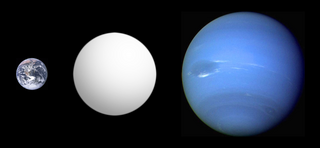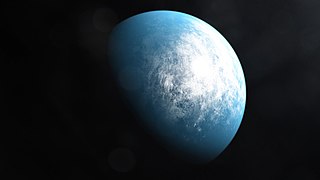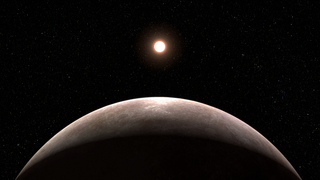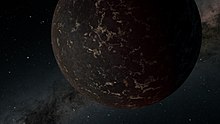
55 Cancri e is an exoplanet in the orbit of its Sun-like host star 55 Cancri A. The mass of the exoplanet is about 8.63 Earth masses and its diameter is about twice that of the Earth, thus making it the first super-Earth discovered around a main sequence star, predating Gliese 876 d by a year. It takes fewer than 18 hours to complete an orbit and is the innermost-known planet in its planetary system. 55 Cancri e was discovered on 30 August 2004. However, until the 2010 observations and recalculations, this planet had been thought to take about 2.8 days to orbit the star. In October 2012, it was announced that 55 Cancri e could be a carbon planet.

Gliese 436 b is a Neptune-sized exoplanet orbiting the red dwarf Gliese 436. It was the first hot Neptune discovered with certainty and was among the smallest-known transiting planets in mass and radius, until the much smaller Kepler exoplanet discoveries began circa 2010.

Epsilon Eridani b, also known as AEgir [sic], is an exoplanet approximately 10.5 light-years away orbiting the star Epsilon Eridani, in the constellation of Eridanus. The planet was discovered in 2000, and as of 2023 remains the only confirmed planet in its planetary system. It orbits at around 3.5 AU with a period of around 7.6 years, and has a mass around 0.6 times that of Jupiter. As of 2023, both the Extrasolar Planets Encyclopaedia and the NASA Exoplanet Archive list the planet as 'confirmed'.
HAT-P-12 is a magnitude 13 low-metallicity K dwarf star approximately 463 light years away in the constellation Canes Venatici, which hosts one known exoplanet.

WASP-19b, formally named Banksia, is an exoplanet, notable for possessing one of the shortest orbital periods of any known planetary body: 0.7888399 days or approximately 18.932 hours. It has a mass close to that of Jupiter, but by comparison has a much larger radius ; making it nearly the size of a low-mass star. It orbits the star WASP-19 in the Vela constellation. At the time of discovery it was the shortest period hot Jupiter discovered as planets with shorter orbital periods had a rocky, or metallic composition.

GJ 1214 b is an exoplanet that orbits the star GJ 1214, and was discovered in December 2009. Its parent star is 48 light-years from the Sun, in the constellation Ophiuchus. As of 2017, GJ 1214 b is the most likely known candidate for being an ocean planet. For that reason, scientists often call the planet a "waterworld".

GJ 1214 is a dim M4.5 red dwarf star in the constellation Ophiuchus with an apparent magnitude of 14.7. It is located at a distance of 47.8 light-years from Earth. GJ 1214 hosts one known exoplanet.

GJ 3470 b is an exoplanet orbiting the star GJ 3470, located in the constellation Cancer. With a mass of just under 14 Earth-masses and a radius approximately 4.3 times that of Earth's, it is likely something akin to Neptune despite the initially strong belief that the planet was not covered in clouds like the gas giants in the Solar System.

WASP-121b, formally named Tylos, is an exoplanet orbiting the star WASP-121. WASP-121b is the first exoplanet found to contain water in an extrasolar planetary stratosphere. WASP-121b is in the constellation Puppis, and is about 858 light-years from Earth.

HIP 65426 b, formally named Najsakopajk, is a super-Jupiter exoplanet orbiting the star HIP 65426. It was discovered on 6 July 2017 by the SPHERE consortium using the Spectro-Polarimetric High-Contrast Exoplanet Research (SPHERE) instrument belonging to the European Southern Observatory (ESO). It is 385 light-years from Earth. It is the first planet discovered by ESO's SPHERE instrument.
TOI-700 is a red dwarf 101.4 light-years away from Earth located in the Dorado constellation that hosts TOI-700 d, the first Earth-sized exoplanet in the habitable zone discovered by the Transiting Exoplanet Survey Satellite (TESS).

TOI-700 d is a near-Earth-sized exoplanet, likely rocky, orbiting within the habitable zone of the red dwarf TOI-700, the outermost planet within the system. It is located roughly 101.4 light-years (31.1 pc) away from Earth in the constellation of Dorado. The exoplanet is the first Earth-sized exoplanet in the habitable zone discovered by the Transiting Exoplanet Survey Satellite (TESS).
GJ 3470 is a red dwarf star located in the constellation of Cancer, 96 light-years away from Earth. With a faint apparent magnitude of 12.3, it is not visible to the naked eye. It hosts one known exoplanet.
WASP-69, also named Wouri, is a K-type main-sequence star 164 light-years away. Its surface temperature is 4782±15 K. WASP-69 is slightly enriched in heavy elements compared to the Sun, with a metallicity Fe/H index of 0.10±0.01, and is much younger than the Sun at 2 billion years. The data regarding starspot activity of WASP-69 are inconclusive, but spot coverage of the photosphere may be very high.

Gliese 486, also known as Wolf 437 and formally named Gar, is a red dwarf star 26.4 light-years away in the constellation Virgo. It hosts one known exoplanet.

L 98-59 b is an exoplanet having a size between that of the Earth and Mars and a mass only half that of Venus. It orbits L 98-59, a red dwarf 35 light-years away in the constellation Volans. There are at least 3 other planets in the system: L 98-59 c, d, e, and the unconfirmed L 98-59 f. Its discovery was announced on 27 June 2019 on the NASA website. It was the smallest planet discovered by TESS until the discovery of LHS 1678b, and was the lowest-mass planet whose mass has been measured using radial velocities until Proxima Centauri d was found in 2022.
Gliese 367 is a red dwarf star 30.7 light-years from Earth in the constellation of Vela. It is suspected to be a variable with amplitude 0.012 stellar magnitude and period 5.16 years. A stellar multiplicity survey in 2015 failed to detect any stellar companions to Gliese 367. It hosts three known exoplanets, Gliese 367 b, c & d.
LHS 3844 is a red dwarf star located 48.5 light-years away from the Solar System in the constellation of Indus. The star has about 15% the mass and 19% the radius of the Sun. It is a relatively inactive red dwarf with a slow rotation period of about 128 days, though UV flares have been observed. LHS 3844 is orbited by one known exoplanet.
LTT 9779 is a G-type main-sequence star located 264 light-years away from the Solar System in the constellation of Sculptor. The star is about 95% the radius and about the same mass as the Sun, but younger than the Sun at 1.7 billion years old, hence its lower luminosity. It has a temperature of 5,443 K and a rotation period of 45 days. LTT 9779 is orbited by one known exoplanet.

LHS 475 is a red dwarf star located 40.7 light-years away from the Solar System in the constellation of Octans. It hosts one known exoplanet.













